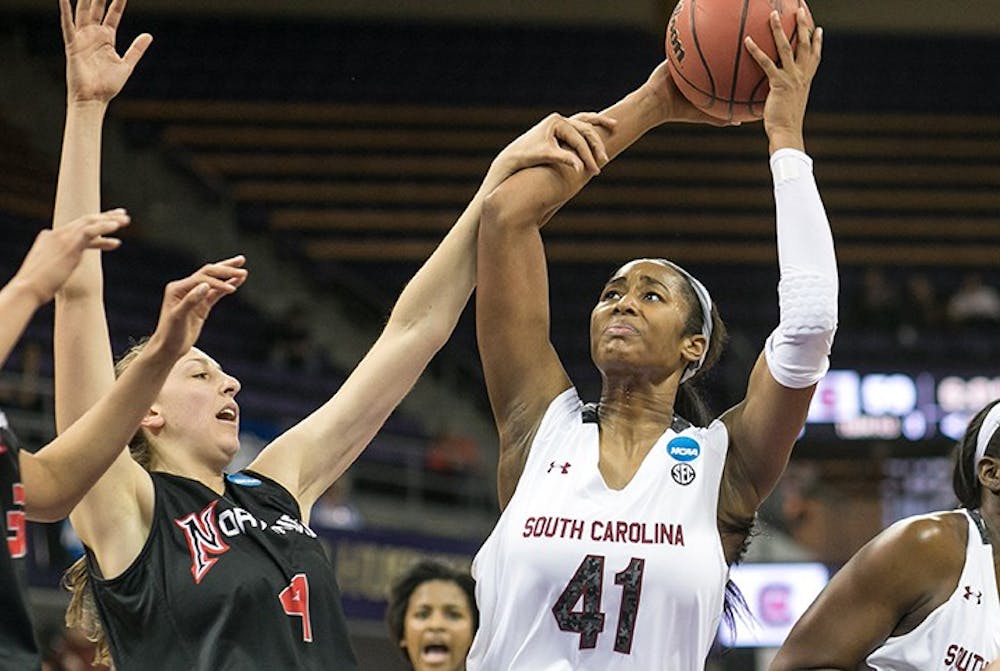In the semifinals of the SEC tournament earlier this season, the South Carolina women’s basketball team faced an upset-minded LSU squad. The Tigers had lost handedly in their two prior games against the Gamecocks earlier in the season, but LSU made its third matchup with South Carolina very interesting, leading 31-27 at halftime. The Tigers were just 20 minutes away from stunning South Carolina, the league’s regular-season champion.
Insert Tina Roy.
Roy, a junior guard who regularly comes off the bench for the Gamecocks, scored 12 of her 15 points in the second half and reenergized South Carolina. Just like that, the Gamecocks were off to the races, en route to a 74-54 victory.
That’s just one example of the South Carolina bench stepping up for head coach Dawn Staley this season.
It’s not fair to call those who don’t start for the Gamecocks reserves. In some cases, they’re the stars.
Guard/forward A’ja Wilson, the SEC freshman of the year, has started just one game in her first year at the college level, but you wouldn’t know that by her stats. Wilson’s 13.3 points per per game and 52.4 percent shooting percentage would warrant her a starting role on almost any team in America, but Staley has the luxury of sending her budding superstar to the scorer’s table several minutes after the tip-off.
The idea that Wilson, the former No. 1 high school prospect in the country, isn’t good enough to crack the starting five is a warning signs of sorts to other teams: South Carolina has talent. A lot of it.
As Vanderbilt head coach Melanie Balcomb put it after her team’s 89-59 loss to the Gamecocks back in February, “[Staley’s] best five come off the bench, pretty much.”
Perhaps there’s a bit of exaggeration in Balcomb’s claim. After all, junior guard Tiffany Mitchell, the SEC’s back-to-back player of the year, and senior forward Aleighsa Welch, the heart and soul of this year’s South Carolina team, are both starters.
But there is a truth in what Balcomb said. Roy, Wilson, sophomore center Alaina Coates, freshman guard Bianca Cuevas and freshman center Jatarie White, the five most frequent substitutes for South Carolina, account for 48.2 percent of the Gamecocks’ points per game.
Even senior guard Olivia Gaines, a junior college transfer, has carved out a role as a defensive stopper.
That kind of depth is rare in women’s basketball and the Gamecocks use it to their advantage. When teams tire of a player like Welch, who wears opponents down with her relentlessness in the paint, they’re then faced with someone with fresh legs like Coates.
One year removed from winning the SEC freshman of the year award, Coates recently admitted that she thinks she’s “simmered a little.” But what she might think of as a sophomore slump, others may consider an excellent season.
Coates averages 10.6 points per contest, third best on the team and her 6’4” frame has helped her earn a spot on the 2014-2015 SEC All-Defensive team.
Coates should start for South Carolina come next season, but she’s been a bench player in most of the games she’s played in at the college level.
The way she sees it, that’s fine. In fact, being able to check into a game and immediately leave her mark is something Coates takes pride in.
“Just coming in and being able to make an impact as great as that and people can notice that, I take a lot of pride in that,” Coates said.
As the season nears its end, but most important stretch, South Carolina should depend on its multitude of options more than ever. Schedules become compressed and players become more fatigued as the stakes rise.
Staley knows that much and she’s fortunate for what she calls the best bench production in the country.
“It’s going to help us be game ready,” Staley said. “We’re going to be allowed to have fresh legs and different ones.”

